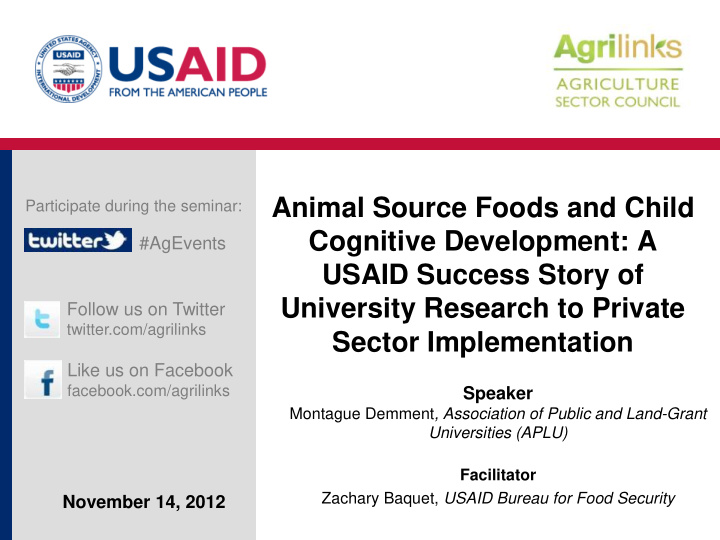



Animal Source Foods and Child Participate during the seminar: Cognitive Development: A #AgEvents USAID Success Story of University Research to Private Follow us on Twitter twitter.com/agrilinks Sector Implementation Like us on Facebook facebook.com/agrilinks Speaker Montague Demment , Association of Public and Land-Grant Universities (APLU) Facilitator Zachary Baquet, USAID Bureau for Food Security November 14, 2012
Agrilinks Blog Latest Developments in Food S ecurity Agrilinks blog
Upcoming Events Upcoming Ag Sector Council • December 5 | Enabling Agricultural Trade (EAT) Project: Fertilizer Policy
Montague Demment Association of Public Land-grant Universities (APLU) Department of Plant Sciences University of California, Davis
Reduce Poverty & Malnutrition Improve Child & Greater Economic & Maternal Nutrition Social Development Improve Education System Greater Knowledge, Technology & Entrepreneurial Activity Improve Workforce
• Nutrition CRSP Research 1980s: Kenya, Egypt and Mexico; (UC- Berkeley, UCLA, UCONN, Instituto Nacional de la Nutricion (Mexico), U of Nairobi, Purdue, National Institute of Nutrition-Cairo, UMass, U of Miami)
• Global Livestock CRSP • Child Nutrition Project (1996-2002): Kenya; (UCLA, UCD, U of Hawaii, U of Nairobi, Kenya Ministries of Education and Health, Wageningen U) • ENAM Project (2005 – 2010): Ghana; (ISU, McGill, U of Ghana, Heifer International, Freedom from Hunger, Ghana Rural Banks)
• Immune system function • Child cognitive and physical development • Work productivity • Lifespan • Quality of life
• 1977 NRC conducts “World Food Study” • Does moderate malnutrition have impact on human function? • Energy thought to be main causal factor Implications for intervention! • In response, USAID funds the HN-CRSP • Observational, non-intervention study in Mexico, Kenya, and Egypt.
• QUALITY was a much stronger determinant of nutritional status than was the quantity. • ASF were best predictor of cognitive function. • Sadly ignored because not an intervention study.
PRINCIPAL INVESTIGATORS Charlotte G. Neumann, MD, MPH UCLA Nimrod O. Bwibo, MBBS, MPH U of Nairobi Suzanne P. Murphy, PhD, RD U of Hawaii Lindsay Allen, PhD UC Davis Funded by USAID through Global Livestock CRSP Other support: National Cattlemen’s Beef Assoc. (NCBA), James Coleman African Study Center (UCLA), Thrasher Research Fund.
21 20 Control Calorie 19 Milk Meat 18 17 -0.5 0 0.5 1 1.5 2
40 C HANGE IN TOTAL EXAM SCORE 35 30 25 20 15 10 5 0 M EAT * M ILK E NERGY C ONTROL -5 *Feeding group scores controlled for baseline scores: Meat significantly greater change.
Behavior during play Compared to all other groups, the MEAT GROUP
THE MEAT GROUP • Had greatest increase in % time spent in high activity levels, and least % time in low activity. • Spent more % time in leadership and initiative. • Were more talkative, playful – and “disruptive”.
PRINCIPAL INVESTIGATORS Grace S. Marquis, PhD Iowa State U/McGill U Anna Lartey, PhD U of Ghana Esi Colecraft U of Ghana O. Sakyi-Dawson U of Ghana Funded by USAID through Global Livestock CRSP
• SURVEY: What limits children’s consumption of ASF? • RESULTS: Knowledge of nutritional impacts of food groups Income of household • INTERVENTION EXPERIMENT: Form women’s groups Nutrition education IGA Microfinance
Nutrition education on optimal feeding practices and benefits Capacity building in Poor Nutrition of ASF for children research and Knowledge extension Inadequate Unequal nutrition household knowledge of allocation ASF extension staff availability, accessibility, utilization Inadequate Cultural beliefs & market linkages practices Training for AFS Low caregiver income generating income Financial support for activities and caregiver’s income entrepreneurial skills generating activities
BASELINE DATA COLLECTION • • 629 intervention and control caregivers and their 2-5 year old child EXPERIMENTAL DESIGN • • ENAM caregivers in implementing communities (n=181) • Non-participant Caregivers in implementing communities (n=142) • Caregivers in non-implementing communities (n=287) DATA • • Nutritional knowledge • Diet diversity of children • Child nutritional state • Women’s income • Household Food security
• 56% decrease in household food insecurity • Increased income for women • Increased consumption of ASF by children • Increase in protein, calcium, iron and zinc in diet of children • Improved child nutrition status (wgt/age) • Rural banks now involved.
• Over $2 million loaned, 2,200 women involved and 100% repayment of loans. • Majority income for original women participants are now sending their kids to private school. • One ENAM trainer alone is responsible for over 80 new groups in and around Accra. • The education/microfinance model for ENAM is now the business model for loans through the rural banks. • The recent Nutrition CRSP at USAID is a design consistent with the ENAM Model.
• USAID for years of support John Lewis, Filipe Manteiga, Tom Hobgood, John Thomas, Josette Lewis Joyce Turk • Title XII • Principal Investigators Charlotte Neumann, Nimrod Bwibo, Lindsay Allen, Suzanne Murphy, Grace Marquis, Anna Lartey, Esi Colecraft • All the thousands of participants in the HN-CRSP and GL-CRSP CNP & ENAM • The Rural Banks of Ghana This research was made possible by support to the Global Livestock Collaborative Research Support Program through USAID Grant # PCE-G-00-98-00036-0 to the University of California, Davis.
Thank you Thank you for joining us! Share Feedback Stay In Touch Upcoming Events Please take our 3 Contact Us: Find upcoming events minute survey: agrilinks@agrilinks.org & past presentations: http://bit.ly/ASCnov14 #AskAg Twitter Chat | Zachary Baquet, December 6 th , 2-3pm USAID/BFS: You can also visit the zbaquet@usaid.gov event page to post Ag Sector Council | comments & questions. December 5 th , EAT Project Agrilinks and the Agriculture Sector Council Seminar Series are products of the USAID Bureau for Food Security under the Knowledge-Driven Microenterprise Development (KDMD) project.
Recommend
More recommend